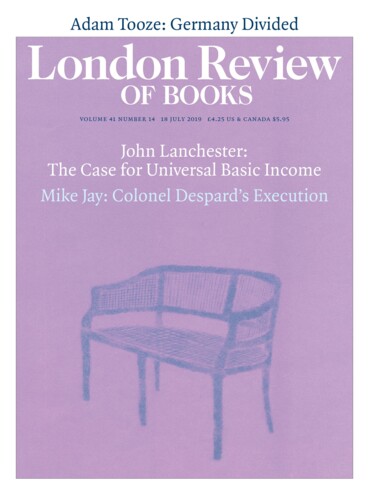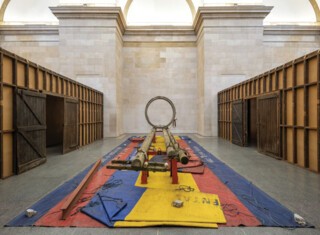You enter Mike Nelson’s installation The Asset Strippers, Tate Britain’s latest commission for its Duveen Galleries (until 6 October), through a pair of wooden swing doors salvaged from the old Royal National Orthopaedic Hospital on Bolsover Street. For several years, Nelson has been acquiring industrial machinery and related artefacts from online auctions and liquidation sales; the first object in the exhibition is a wheeled pneumatic paint sprayer: a thing of tubes and cylinders, coiled rubber hose and steel nozzle, all caked in dark red paint. Behind the sprayer – which vaguely resembles the ‘bride’ or one of her mysterious machinic ‘bachelors’ in Duchamp’s Large Glass – sit various towering contraptions, oil-stained and blackening: a meeting of anthropomorphic or zoomorphic machines, with their great heads and fragile limbs, their blank gazes made of lights and dials. Many of them are painted in colours peculiar to their manufacturers: the eau de nil of Wadkin of Leicester; the vivid blue of H.W. Ward & Co., Birmingham.
What are, or were, they all for? Some of the force of The Asset Strippers, its summoning of defunct or vanishing British industry, depends on gallery-goers having no clue what such machines actually do. But the exhibition is surprisingly legible. Nelson, who is 51, grew up in Loughborough, where his parents and his grandfather worked in the textile industry. At the Duveen Galleries there are looms and knitting machines (from a factory in Canning Town), towers of bright yarn, cupboards and boxes disgorging colour and shine. Other machines and materials are more enigmatic, and you find yourself trying to guess their purpose from the postwar typography of nameplates – ‘Property of the Atomic Energy Authority’ – and instructions: ‘The outside faceplate must run at the two lower speeds only.’
Reviews of The Asset Strippers have tended to describe the installation as if it were simply an agglomeration of found objects, thrust together and left to do the work of historical recall, and it’s possible to treat the Duveen Galleries as a capriciously assembled industrial museum, except that it’s a museum in which the texture of industrial decline and decay has been meticulously preserved along with the technology. The textile machines, like many other objects in the show, are richly furred with a mixture of dust and oil (the whole place smells of it), and in this black mulch are preserved countless colourful, glinting sequins from the machines’ dressmaking days. At the summit of one, a spider’s web thickened with dust clings on, trembling.
Otherwise, nothing moves – though you might be put in mind of the clanking kinetic sculptures of Jean Tinguely. There are many other sculptural allusions in The Asset Strippers, some of them openly parodic of the monumental uses to which industrial motifs and materials were put in the 20th century. It’s hard not to be reminded of Jacob Epstein’s The Rock Drill (1913), which includes a plaster figure and an actual rock drill (a later bronze based on the figure is in the Tate collection) or of certain rusted hulks by Richard Serra. And Duchamp again, in the central rotunda, where a digger’s bucket lies on the floor like a big cartoon citation of his snow-shovel readymade of 1915, In Advance of the Broken Arm. Nelson surely intends the ladder-like framework of rusting metal that points towards the ceiling to recall the triangular profile of Tatlin’s Monument to the Third International.
But The Asset Strippers doesn’t simply invoke the matter and form of modern sculpture. Nelson is extremely skilled – to put the preoccupations of 20th-century sculptors a little too starkly – at knowing how to put one thing on top of another. It is mostly a matter of stacking, sometimes of strewing. His plinths – steel desks and cupboards and filing cabinets – are just as redolent of disused factories as the machines they support. Making sense of these objects is another matter. Nelson repeatedly chooses, or puts together, plinths that place the machines not quite out of reach, but high enough to intimidate. Perched off-centre on top of two vertically stacked wooden benches or chests, an old encrusted cement mixer turns its open mouth skywards, like a lonely dog on a Victorian tomb.
There is also a mischievous aspect to these plinths, a reference to the Duveen Galleries’ original purpose and the kind of art exhibited there. The 300-foot-long neoclassical galleries, divided by columns and arches, run through the centre of Tate Britain. They opened in 1937, shortly after George VI was crowned; along their length Nelson has hung a number of large dusty plaques bearing Commonwealth flags and the legend ‘Long May They Reign’. At their centre, instead of the regal ‘GR’, is the cursive ‘GE’ of General Electric. The galleries were paid for by Lord Duveen of Millbank, energetic and ingenious purveyor of Old Masters to the grandest industrialists and financiers of North America, and in turn to US and Canadian museums. The Asset Strippers slyly points to the contemporary reliance of art museums on private sponsorship, shadowy assets and investments.
All of this risks making Nelson’s work sound merely documentary or polemical. That would be to ignore its fantastical aspects. Aside from Rachel Whiteread, Nelson may be the contemporary British artist about whom the word ‘uncanny’ has been most used, or misused. There is often, perhaps always, a science fiction strain in his work, informed by the films of Andrei Tarkovsky, the fiction of Stanisław Lem and J.G. Ballard. Take his installation The Coral Reef, which won him a Turner Prize nomination in 2001: the visitor had to navigate a claustral labyrinth of 15 more or less grotty and unsettling rooms, meticulously set-dressed as minicab office, drug den, waiting room. This time there are echoes of Ballard’s Crashed Cars exhibition at the New Arts Laboratory in 1970 and of the sci-fi inflected essays of the land artist Robert Smithson, who in 1967 described post-industrial New Jersey as ‘a place where the machines are idle, and the sun has turned to glass’. In The Asset Strippers, the machines are lying idle but there’s a cunning relay between the ruins of the recent past and our digital present: the textile machines remind us of the origins of computing in Jacquard loom punchcards, and several of Nelson’s industrial artefacts have vestigial power cables still attached, as if conjuring the future collapse of network infrastructure.
In the final two rooms – separated by wooden partitions taken from an army barracks in Shrewsbury – the tone of the show changes. Or perhaps it’s only a matter of the objects’ attitude and orientation. In the penultimate gallery all is suddenly horizontal: a wide section of concrete pipe or tunnel balances on top of a fascicle of three telegraph poles – a reference to Nancy Holt’s Sun Tunnels in Utah. And in the final room, a big black engine rests on a raft of old sleeping bags. Compositionally, it’s Delacroix; historically, it’s entirely up to date, a frail and overweighted migrant craft.
Send Letters To:
The Editor
London Review of Books,
28 Little Russell Street
London, WC1A 2HN
letters@lrb.co.uk
Please include name, address, and a telephone number.


